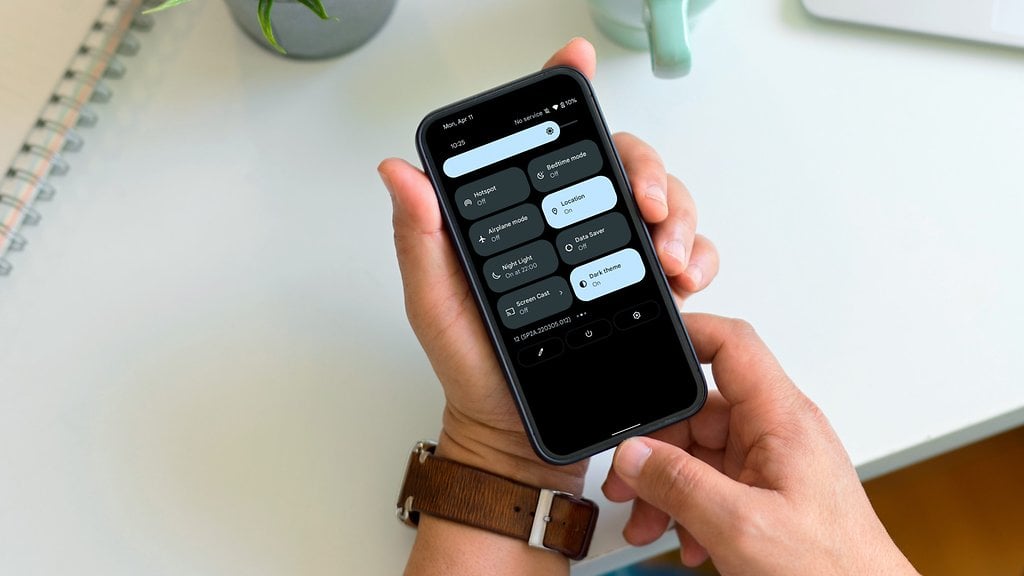December 17th, 2025, posted in for_founders
by Adelina
Dark mode isn't just a trend anymore—it's a full-fledged movement in UI/UX design. What began as a niche feature for night owls and power users has now taken over mainstream digital interfaces. From mobile apps to websites, and even entire operating systems, dark mode has steadily grown in popularity, becoming a default feature that users have come to expect. It's not just a matter of aesthetics; for many, dark mode is synonymous with comfort, usability, and even device efficiency.
But why has dark mode captured the attention of designers and users alike? Is it simply a matter of looking sleek and modern, or is there more driving this demand? As digital interactions become an integral part of our daily lives, factors like eye strain, battery life, and visual focus have pushed dark mode into the spotlight. And while the appeal is evident, implementing dark mode in your designs requires careful consideration. How do you ensure that your interface remains accessible, usable, and true to your brand identity when switching to a darker palette?
The transition to dark mode involves a balance of art and science. It’s about understanding user preferences, adapting color schemes thoughtfully, and navigating potential pitfalls to create an interface that’s both functional and visually striking. So, how can you make sure your dark mode design not only meets user expectations but also elevates the overall experience?
Let’s dive deep into the benefits, challenges, and best practices for designing in the dark and explore how you can leverage this movement to enhance your digital products.
Why dark mode is so popular
Reduced eye strain
For many users, especially those who spend long hours in front of screens, dark mode offers a much-needed reprieve. The high brightness of traditional light mode interfaces can cause eye fatigue, particularly in low-light environments. When users are working late, scrolling through content at night, or gaming in a dim room, the bright white backgrounds and vibrant colors of regular screens can feel overwhelming. Dark mode, with its softer tones and reduced brightness, helps alleviate this discomfort.
Moreover, studies have shown that bright, high-contrast displays can lead to a phenomenon known as "computer vision syndrome," which includes symptoms like dry eyes, blurred vision, and headaches. By switching to darker backgrounds, users can mitigate these issues, resulting in a more comfortable viewing experience. This is why dark mode has become a game changer for night owls, late-night readers, and binge-watchers. It’s not just about aesthetics—it’s about long-term screen health and user comfort.
Improved battery life
In an age where battery life is a top priority for mobile users, dark mode can play a significant role in power conservation, particularly on devices with OLED or AMOLED screens. Unlike traditional LCD screens, OLEDs light up individual pixels, which means displaying darker colors requires less power. When large portions of the screen are black or dark, the device uses fewer resources, extending battery life.
For users who are constantly on the go—whether it’s a busy professional hopping between meetings, a traveler navigating with maps, or simply someone who forgets their charger—this can be a practical benefit. It might seem like a minor advantage at first glance, but the extra hours gained by using dark mode can make a significant difference in how people interact with their devices daily. Some studies have even suggested that dark mode can reduce power consumption by up to 60% in certain scenarios, which adds up over time, especially for those glued to their screens.
Enhanced focus and aesthetics
There's something undeniably sleek and modern about a well-executed dark mode design. It creates an environment that feels calm, focused, and sophisticated. Many users report that dark mode reduces visual distractions, helping them concentrate on the content itself rather than being bombarded by bright backgrounds and excessive colors. The contrast between text and background in a thoughtfully designed dark mode can make information easier to read, which is particularly beneficial for content-heavy apps like e-readers, messaging platforms, and code editors.
Beyond readability, the aesthetics of dark mode play a crucial role in user preference. Brands looking to project a cutting-edge, contemporary vibe often find dark mode aligns well with their identity. It communicates elegance and minimalism, providing a canvas that makes other elements—like imagery, buttons, and typography—stand out in a striking way. Think of how media platforms like Netflix and Spotify use dark interfaces to draw attention to their content, creating an immersive, cinema-like experience. This sense of focus and immersion is a key reason why users are increasingly drawn to dark mode.
Challenges of designing for dark mode
While the benefits of dark mode are clear, implementing it successfully comes with its own set of challenges. Designing for dark mode isn’t as simple as inverting colors; it requires careful thought to ensure the end result is both visually appealing and functional. Here are some of the key hurdles you may encounter:
Maintaining readability
A common misconception is that dark mode design is just about flipping colors. However, one of the biggest challenges lies in ensuring text remains clear and legible. High contrast, like pure white text on a pure black background, can cause glare and lead to eye strain over time. On the other hand, too low a contrast makes text hard to read, especially for users with visual impairments. Striking the right balance is key. Designers must carefully choose background shades (often opting for dark grays instead of pure black) and adjust text colors to offer a more comfortable reading experience. Additionally, attention should be given to smaller text sizes and thinner fonts, as they might require slight modifications in weight or color to maintain clarity in dark mode.
Preserving brand identity
For brands with established color palettes and visual identities, moving to dark mode can be tricky. Colors that look great in light mode can lose their impact against a dark background. Bright hues might appear overly vibrant and clash with the overall aesthetic, while softer shades may blend in and become muted. This is particularly true for logos, icons, and accent elements. A bright yellow logo, for instance, might need adjustments—either by adding a subtle glow or a contrasting outline—to stand out against a dark theme. The challenge is to adapt these elements without losing the brand's essence. It often involves creating an alternate, dark-mode-specific color palette that harmonizes with the overall design while keeping the brand recognizable and consistent.
Accessibility considerations
Accessibility is a fundamental aspect of any design, and dark mode is no exception. Not all users benefit equally from dark mode; some people, especially those with certain visual impairments like astigmatism, may find text harder to read on dark backgrounds. This means designers must ensure that dark mode is not just visually appealing but also accessible to everyone. This includes providing adequate contrast levels, adhering to Web Content Accessibility Guidelines (WCAG), and offering users the ability to toggle between dark and light modes as needed. Additionally, it's important to consider users with color vision deficiencies; for example, certain colors might need to be adjusted to remain distinguishable in a dark theme. Ensuring that dark mode is fully usable and provides the same level of clarity as light mode requires thoughtful planning and testing.
Maintaining visual hierarchy
In light mode, shadows and light sources are often used to create a sense of depth and visual hierarchy. In dark mode, these elements can get lost if not adjusted properly. Designers need to use lighter shades and subtle highlights to indicate elevation and interactive elements, ensuring users can easily distinguish buttons, cards, and other components. Overly dark shadows can disappear into the background, so the use of lighter, less intense shadows is necessary to create a balanced hierarchy in the dark mode.
Handling dynamic media and images
Dark mode also introduces challenges when dealing with dynamic content, such as images, icons, and graphics. Bright images or illustrations can appear too stark against a dark background, causing visual discomfort. On the flip side, darker images can get lost and become indistinguishable. Designers often need to create alternative versions of images and icons, adjust brightness, or add subtle borders to ensure media elements remain visually consistent and cohesive within a dark theme.
Best practices for designing in dark mode
Now that we’ve covered the benefits and challenges, let’s dive into how to implement dark mode effectively. Designing in dark mode is not just a color swap; it requires a thoughtful approach to create a balanced, user-friendly experience. Here are some best practices to keep in mind:
Avoid pure black backgrounds
While pure black (#000000) might seem like the natural choice for dark mode, it can actually be harsh on the eyes, especially when paired with bright text. The stark contrast can lead to eye strain and make it harder for users to focus over long periods. Instead, opt for a very dark grey or charcoal background, such as #121212 or #1A1A1A. These colors provide a softer contrast, creating a more comfortable reading experience. They also help in reducing glare, making text and other elements stand out in a more subtle way. Additionally, a slightly off-black background can enhance the perception of depth, helping to distinguish different interface elements.
Use high contrast for text, but not too high
Readability is key in dark mode, so maintaining a high contrast between text and the background is essential. However, pure white text (#FFFFFF) on a pure black background can create an intense glare that strains the eyes. To avoid this, use off-white shades like #E0E0E0 or #F5F5F5 for text. These softer whites provide the necessary contrast without causing discomfort. Similarly, for other text elements like headings and links, consider using slightly muted or softer colors instead of their bright, saturated versions. This ensures the content is easy to read while retaining a balanced visual aesthetic. If you’re unsure about readability in your app’s design, feel free to check out our free UI/UX expert review!
Respect the user’s preferences
User control is a crucial aspect of a positive experience. If the user’s device or operating system is set to dark mode, your app or website should automatically adapt. This can be achieved using CSS media queries (e.g., @media (prefers-color-scheme: dark)) for web-based designs or platform-specific settings for mobile apps. By aligning with the user’s system preferences, you show respect for their choices and enhance usability. Also, providing a manual toggle for switching between dark and light modes can empower users to adjust the interface based on their environment or personal comfort.
Adjust colors thoughtfully
Not all colors translate well to a dark background. Bright or neon colors, which may work wonderfully in light mode, can appear overly vibrant, harsh, or distracting in dark mode. To maintain a cohesive look, consider using desaturated or muted versions of your brand colors. For example, a vibrant blue might be softened to a more subdued shade, allowing it to blend naturally into the dark theme while still representing your brand. Similarly, avoid using too many bright accent colors, as they can overwhelm the interface and disrupt the visual hierarchy. Instead, use color sparingly and intentionally to draw attention to key elements without overpowering the overall design.
Be mindful of depth and elevation
In light mode, shadows and light sources help create a sense of depth and elevation. In dark mode, however, dark shadows can disappear into the background. To maintain a sense of hierarchy, use lighter shades and subtle highlights to indicate elevated elements like cards, buttons, and modals. For instance, a slightly lighter shade of the background color or a soft glow effect can create the illusion of elevation without relying on heavy shadows. This approach provides a more nuanced way to distinguish different layers in the interface and guides the user's attention effectively.
Test across multiple devices
Dark mode can vary significantly depending on the screen and device. OLED screens, for example, can make dark themes appear richer and deeper, while LCD screens might show colors differently. To ensure a consistent and pleasant experience, test your dark mode design across a range of devices, including smartphones, tablets, laptops, and desktops. Pay close attention to how colors and contrast levels may shift depending on different display technologies. This testing phase will help you catch any inconsistencies and adjust elements as needed to ensure that your design looks and feels right, no matter where it’s being viewed.
Make accessibility a priority
Accessibility should be at the forefront of dark mode design. Ensure that all color contrasts meet the Web Content Accessibility Guidelines (WCAG), which recommend a minimum contrast ratio of 4.5:1 for normal text and 3:1 for large text. This helps ensure that users with visual impairments, such as color blindness or low vision, can comfortably read and interact with your content. Additionally, some users may prefer light mode or require specific adjustments to suit their needs. Providing a quick toggle for switching between dark and light modes, along with customizable contrast settings, can significantly enhance accessibility and user experience.
Keep imagery consistent
If your app or website relies heavily on images, illustrations, or icons, you need to adapt these assets for dark mode. Bright images or graphics can appear too stark against a dark background, disrupting the overall aesthetic. Consider creating alternative versions of images, adjusting their brightness, or adding a semi-transparent overlay to blend them into the dark environment. For icons and illustrations, opt for lighter, more muted tones that maintain visibility without overpowering the interface. This consistency helps in preserving the visual harmony of your design and ensures that media elements are as effective in dark mode as they are in light mode.

© BongkarnGraphic/Adobe Stock
Brands doing dark mode right
Some brands have already nailed their dark mode design:
- Apple and Google were among the first to champion dark mode in their operating systems, setting a standard for others to follow. Both companies carefully adjusted their design elements, colors, and contrasts to provide a consistent experience in both light and dark modes.
- Instagram and Twitter have also effectively implemented dark mode, offering users a seamless experience that adapts to their system preferences. They maintained brand identity while ensuring readability and accessibility, balancing vibrant images and dark backgrounds.
- Netflix has always had a dark interface, and it's not just for aesthetics. The dark UI makes it easier for viewers to focus on content, creating an immersive experience, especially in dimly lit environments.
Dark mode is more than just a passing trend—it's becoming a standard feature that users appreciate and expect. By carefully considering the benefits and challenges, and following best practices, you can create a dark mode experience that not only looks good but also enhances usability, accessibility, and brand identity.
Tired of stumbling in dark mode? Book a free UI/UX assessment with us and let's shed some light on your design.

















